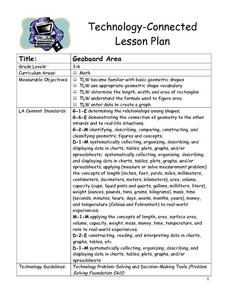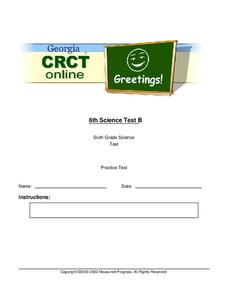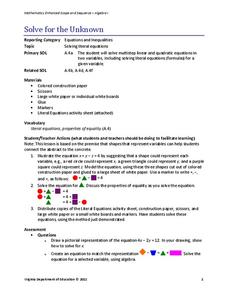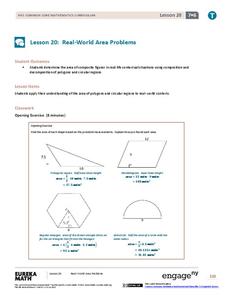Curated OER
Volume of Solids
In this volume of solids worksheet, tenth graders solve and complete 20 various types of problems. First, they write the formula needed to find the volume of each solid. Then, pupils use the Pythagorean theorem to find the measure of the...
Curated OER
Measurement: 2D and 3D
Young scholars solve volume problems. In this geometry lesson, the class watches a video about clean water (link provided) and individuals compare the volume of different prisms, including an actual drinking glass. Extension activities...
Curated OER
Flower Vases
Which vase holds more water: a cylinder, sphere, or cone? Figure out which should be used for your sister's birthday bouquet with this practical word problem.
Curated OER
Area of Combined Shapes - Turtle Combo
High schoolers graph polygons using the name and number of sides. In this geometry lesson, students identify the formula to calculate the area and perimeter of polygons. They relate the formula to different polygons and shapes.
Pennsylvania Department of Education
Euler's Formula
Students explore geometry by defining a list of vocabulary terms. For this shape characteristics lesson, students identify a number of different shapes and discuss the amount of edges, vertices, and faces using the Euler formula....
Curated OER
Math 312 Spring 98: Cauchy's Integral Formula
In this integral formula worksheet, students find the area of odd shapes by using the contour integration formula. They compute the area enclosed by an ellipse. This two-page worksheet contains three problems.
Curated OER
Use Formulas for Perimeter
In this perimeter formula learning exercise, students solve a set of 6 word problems related to the perimeter of various shapes, then tell how they arrive at the answer.
BW Walch
Linear & Exponential Functions
Positioned inside the framework of linear and exponential functions, this lesson is more of an investigation into the effects of changing variables and constants inside an expression. The author takes familiar formulas, those for...
Curated OER
The Ins And Outs Of Area And Perimeter
Fifth graders demonstrate the concept of perimeter and area using manipulative. In this area and perimeter lesson, 5th graders explore area and perimeter through the exploration style of teaching using eatable and non-eatable...
Curated OER
Geoboard Area
Young scholars explore the basic geometric shapes and geometric shape vocabulary through the use of geoboards and virtual geoboards. They create a variety of shapes with a partner, build ten different rectangles on their geoboards, and...
Curated OER
Models of Hydrocarbons
Students construct models of hydrocarbon molecules using candy and toothpicks. In this hydrocarbons lesson plan, students are given a sheet with the molecular formulas of hydrocarbons. As a group, they construct each molecule using...
Curated OER
Sixth Grade Science Test
For this science worksheet, 6th graders take a multiple choice quiz about properties, energy, formulas, and more. Students complete 30 questions total.
Curated OER
Candy Land
For this activity middle schoolers pretend that they have been hired by a candy manufacturer to design a box for a new product they are beginning to market. The manufacturer has pre-determined the volume of the candy box. It is the...
Curated OER
Using Polynomials To Find Perimeter
Fifth graders engage in the solving of a real life application problem using the concept of calculating perimeter. They apply the operations of calculating with the polynomials for finding the perimeter of triangles,quadrilaterals, and...
Curated OER
Simple Formulae and using Formulae
In this formulae worksheet, students review how to find an expression for the perimeter of a shape, then find expressions for perimeter of 2 given triangles.
Mrs. Burke's Math Page
The Amazing Pi Race
Add a sense of excitement to your math class with this race across the country. Using their knowledge of all things circular, young mathematicians work in pairs answering a series of pi-related word problems as they hop from one city to...
Charleston School District
Solving for a Missing Dimension
If a can has a volume of twelve ounces, how tall it should be? If you can work with volume formulas, it's is an easy measurement to find. After finding the volume of figures in the previous lesson of the series, learners now...
Virginia Department of Education
Solve for the Unknown
How can shapes help solve literal equations? Scholars first learn to replace variables with shapes to aid in solving literal equations. A worksheet of practice problems helps hone the skill.
Concord Consortium
Strings and Areas
You'd be surprised what you can do with a string! The constraint is the length of string, and the task is to maximize area. Given a series of composite shapes, learners must create a formula for the maximum area for a specified...
Alabama Learning Exchange
Polygons-Changing Area Versus Changing Perimeter
Investigate the area and perimeter of polygons in this geometry lesson. Young geometers use grid paper to draw a quadrilateral and calculate its area and perimeter. They also read The Greedy Triangle to identify the changing shape of...
Mathematics Vision Project
Module 6: Congruence, Construction, and Proof
Trace the links between a variety of math concepts in this far-reaching unit. Ideas that seem very different on the outset (like the distance formula and rigid transformations) come together in very natural and logical ways. This...
Howard County Schools
Building a Playground
Scholars crave practical application. Let them use the different models of a quadratic function to plan the size and shape of a school playground. They convert between the different forms and maximize area.
EngageNY
Real-World Area Problems
Not all structures take the shape of a polygon. The 21st lesson in a series of 29 shows young mathematicians they can create polygons out of composite shapes. Once they deconstruct the structures, they find the area of the composite figure.
Illustrative Mathematics
Finding Areas of Polygons, Variation 1
An exercise in finding the area of polygons by decomposing into triangles and composing into rectangles is the focus of this resource. Make several copies of the worksheet for each participant. Ask learners to use colored pencils to...























